What is Geofencing? The Art of Advertising By Location
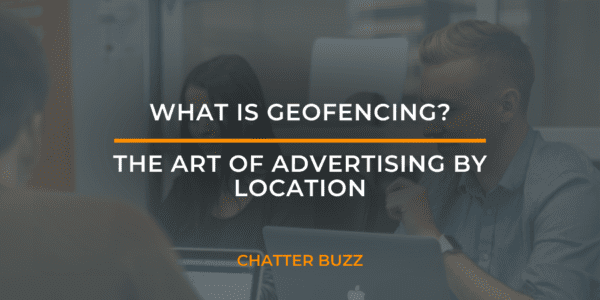
In 2021, the use of geofencing in digital advertising is more important than ever. This year, 54.8% of internet traffic came from mobile devices… and that number is constantly growing!
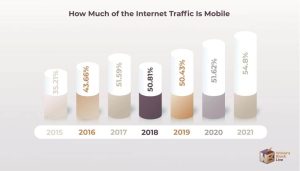
Consumers are returning to life as normal after 2020’s challenges. This means that now is the perfect time to start using geofencing as a part of your digital marketing strategies!
So, let’s get right to the point…
What is Geofencing?
Geofencing uses location services (such as RFID, Wi-Fi, GPS, and cellular data) to create a virtual perimeter around a real-world location.
This technology has many uses, but it is most often used by marketers to advertise to audiences within specific, customized geographic areas.
How Does It Work?
When a mobile device leaves or enters a set area, a digital marketing message is triggered. This message may come in the form of social media advertisements, emails, texts, or app notifications.
Marketers love geofencing because it’s yet another tool that allows us to use laser-focused targeting to reach audiences with the right message at the right time.
Geofencing typically targets smaller locations, to make use of hyper-targeted messaging when a customer enters the geofence.
As an example, Starbucks often advertises in cities using geofencing.
Imagine this situation: You’re on a weekend shopping trip in the local mall, and you’re on your way to the shoe store to pick up a new pair of Nikes. To get there, you have to walk past a few other stores, the food court, and a Starbucks. (You should have parked on the other end)!
After you walk past the Starbucks, your phone chimes, and you see a notification from Starbucks reading “You are near Starbucks, 50% off an espresso!”
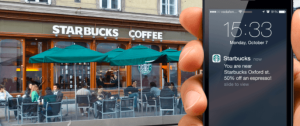
You are excited because that’s just the energy boost you needed for your shopping day!
You go inside, grab an espresso, and walk away with a feeling of satisfaction that Starbucks has your back and works hard to notify you about deals at the right place and the right time.
This allows Starbucks to draw in customers who might have otherwise walked or drove right past their location.
Additionally, this is a great way to attract and delight customers, with highly targeting messaging that’s likely to make them feel good about the brand.
How is Geofencing Different From Other Location Targeting Services?
Although geofencing, geotargeting, and beaconing are all location-based marketing tools, they each work differently and serve different purposes.
Let’s start with Geofencing.
Geofencing
Geofencing often targets a small area, usually with a specific promotion in mind.
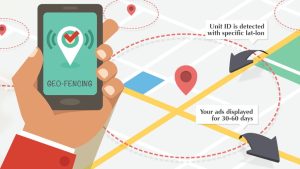
Geofencing is typically used to send specific messaging to people who are near a store location. This means it only needs to create a “geofence” around a smaller area, not a whole city or state.
So now that we’ve discussed geofencing, how do geotargeting and beacon marketing differ?
Geotargeting
Geotargeting is used in paid advertising to show ads in larger locations
Geotargeting allows you to show ads in larger areas such as cities, counties, or states.
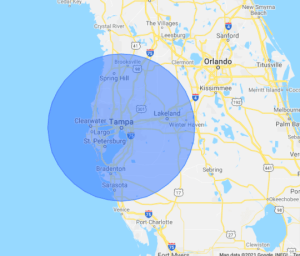
This helps marketers get the most out of their PPC budgets by including only relevant cities, counties, or states.
This technology is especially helpful because you wouldn’t want to see an ad for “Your Local Orlando Autodealer” if you lived in Tampa!
Beacon Marketing
Beacon Marketing is Bluetooth technology that is used to create a unique shopping experience within a store.
![]()
In beacon marketing, a small, battery-powered beacon is installed throughout a location that emits a Bluetooth signal known as BLE.
Once the beacons are set up, mobile devices will pick up the BLE signal when in proximity to them and a push notification will be sent directly to the device with a distinct message.
Consumers receive a customized user experience including discounts, suggestions, and more.
So to compare these location-based tools side by side…
Geotargeting typically targets a large location such as a city, state, or 10+ mile radius around a location, so that only ads relevant to the area are shown.
Geofencing typically targets smaller locations, such as a specific store, or a 2-5 block radius around an area, and sends a targeted marketing message to a mobile device when it enters or exits the geofence.
Beacon marketing typically targets an area within a store, or near it. Brands use this Bluetooth technology to send offers to customers while they are within a store and to create a unique shopping experience.
How Can Geofencing Grow My Business
Geotargeting has a few key benefits that truly help with business growth and make a positive impact for marketers and consumers alike.
Geofencing Allows For Precise Targeting
Geofencing allows you to target audiences based on their precise location and apply other targeting criteria, such as demographics and time of day.
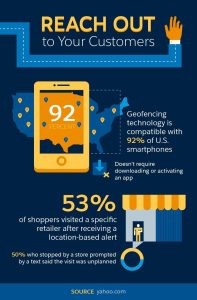
This level of precision allows you to send highly relevant messages to your customers that are much more likely to engage, attract, and delight.
If you were a marketer for Kate Spade you may choose to send discount notifications to women who are walking within half a mile of the store between 11am and 2pm. This allows you to engage with this specific audience group in a much more personal way.
Geofencing Allows For More Efficient Ad Spend
By targeting many specific criteria, the savvy marketer may be able to save money on their ad budget and spend more effectively.
Geofencing provides the tools to allow for a much higher chance of “conversion” when the audience has been narrowed down by highly specific factors.
Geofencing Adds New Opportunities for Competitive Advantages
Geofencing technology also allows for new tactics to target your competitor’s potential customers.
You could, for instance, send up geofenced ADs for 25% off at Wendy’s around a few of the McDonalds locations in the area. This could cause some consumers to seek out a Wendys to take advantage of the potential savings.
Best Practices for Advertising using Geofencing
So what are the best practices associated with geofence marketing?
Here are a few key tips that can assist you in your efforts.
Keep Your Geofence Small
For precise targeting, you want to have a small geographic area. Widening the scope too much could decrease effectiveness.
You’ll want to come up with a strategy in advance and hopefully decide on one or more specific locations that work into your strategy.
At most, you can keep it to a 4 or 5-mile radius, but usually, you’ll want to target geofencing around specific businesses, or a few blocks around a neighborhood.
Remember that the idea of geofencing is to target people who are no more than a few minutes away from your business.
Craft a Simple & Easy to Understand CTA
The most effective CTAs for geofencing will be clear and ask for immediate action.
Usually, the goal with geofence marketing is to encourage customers to walk through your doors, so give them a clear & compelling reason to do so!
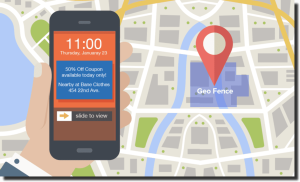
(i.e.) “You are nearby! Stop in & save 15%”.
It’s best practice to stay away from general announcements such as simply advertising an ongoing promotion. You want to offer something special to customers for being in the area.
Geofencing Can be Part of a Balanced Marketing Plan
Remember, marketing is not a one-size-fits-all approach.
For the best results, you should integrate geofence marketing into a larger marketing plan for your business. Geofencing campaigns can often synergize well with other parts of your strategies such as email marketing and social media.
Getting Started with Geofencing in 2021
2021 is a great time to get started with geofence marketing because consumers are coming out of their homes and getting back out in the world!
Remember: Tthe main benefits of geofenced marketing are higher precision targeting, efficient ad spending, and the creation of new competitive advantages.
Here at Chatter Buzz, we value highly targeted and efficient strategies such as geofenced marketing. We’re always here to help if you want to learn more about our geofencing services or digital marketing services as a whole!
Do you need someone to help you achieve your growth goals - then let us help you crush them? Let's chat!
Error: Contact form not found.









